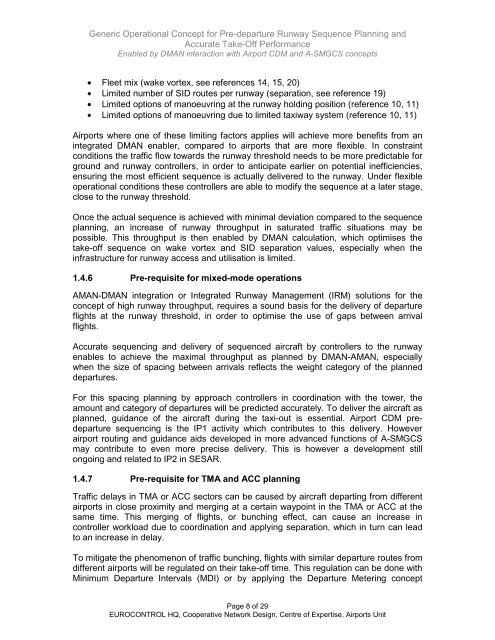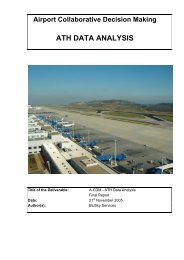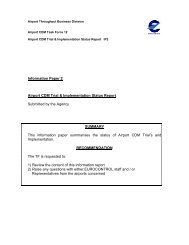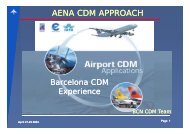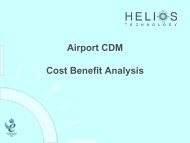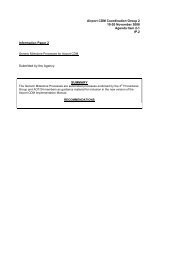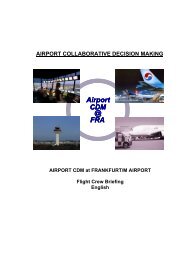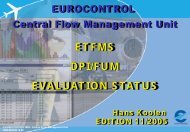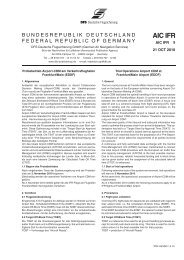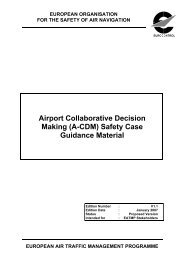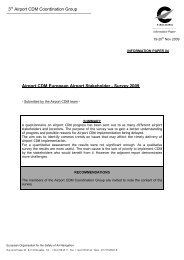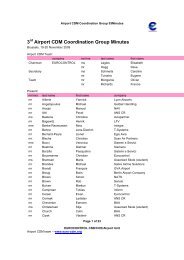Generic Operational Concept for DMAN Interaction v07A - Airport ...
Generic Operational Concept for DMAN Interaction v07A - Airport ...
Generic Operational Concept for DMAN Interaction v07A - Airport ...
Create successful ePaper yourself
Turn your PDF publications into a flip-book with our unique Google optimized e-Paper software.
<strong>Generic</strong> <strong>Operational</strong> <strong>Concept</strong> <strong>for</strong> Pre-departure Runway Sequence Planning and<br />
Accurate Take-Off Per<strong>for</strong>mance<br />
Enabled by <strong>DMAN</strong> interaction with <strong>Airport</strong> CDM and A-SMGCS concepts<br />
• Fleet mix (wake vortex, see references 14, 15, 20)<br />
• Limited number of SID routes per runway (separation, see reference 19)<br />
• Limited options of manoeuvring at the runway holding position (reference 10, 11)<br />
• Limited options of manoeuvring due to limited taxiway system (reference 10, 11)<br />
<strong>Airport</strong>s where one of these limiting factors applies will achieve more benefits from an<br />
integrated <strong>DMAN</strong> enabler, compared to airports that are more flexible. In constraint<br />
conditions the traffic flow towards the runway threshold needs to be more predictable <strong>for</strong><br />
ground and runway controllers, in order to anticipate earlier on potential inefficiencies,<br />
ensuring the most efficient sequence is actually delivered to the runway. Under flexible<br />
operational conditions these controllers are able to modify the sequence at a later stage,<br />
close to the runway threshold.<br />
Once the actual sequence is achieved with minimal deviation compared to the sequence<br />
planning, an increase of runway throughput in saturated traffic situations may be<br />
possible. This throughput is then enabled by <strong>DMAN</strong> calculation, which optimises the<br />
take-off sequence on wake vortex and SID separation values, especially when the<br />
infrastructure <strong>for</strong> runway access and utilisation is limited.<br />
1.4.6 Pre-requisite <strong>for</strong> mixed-mode operations<br />
AMAN-<strong>DMAN</strong> integration or Integrated Runway Management (IRM) solutions <strong>for</strong> the<br />
concept of high runway throughput, requires a sound basis <strong>for</strong> the delivery of departure<br />
flights at the runway threshold, in order to optimise the use of gaps between arrival<br />
flights.<br />
Accurate sequencing and delivery of sequenced aircraft by controllers to the runway<br />
enables to achieve the maximal throughput as planned by <strong>DMAN</strong>-AMAN, especially<br />
when the size of spacing between arrivals reflects the weight category of the planned<br />
departures.<br />
For this spacing planning by approach controllers in coordination with the tower, the<br />
amount and category of departures will be predicted accurately. To deliver the aircraft as<br />
planned, guidance of the aircraft during the taxi-out is essential. <strong>Airport</strong> CDM predeparture<br />
sequencing is the IP1 activity which contributes to this delivery. However<br />
airport routing and guidance aids developed in more advanced functions of A-SMGCS<br />
may contribute to even more precise delivery. This is however a development still<br />
ongoing and related to IP2 in SESAR.<br />
1.4.7 Pre-requisite <strong>for</strong> TMA and ACC planning<br />
Traffic delays in TMA or ACC sectors can be caused by aircraft departing from different<br />
airports in close proximity and merging at a certain waypoint in the TMA or ACC at the<br />
same time. This merging of flights, or bunching effect, can cause an increase in<br />
controller workload due to coordination and applying separation, which in turn can lead<br />
to an increase in delay.<br />
To mitigate the phenomenon of traffic bunching, flights with similar departure routes from<br />
different airports will be regulated on their take-off time. This regulation can be done with<br />
Minimum Departure Intervals (MDI) or by applying the Departure Metering concept<br />
Page 8 of 29<br />
EUROCONTROL HQ, Cooperative Network Design, Centre of Expertise, <strong>Airport</strong>s Unit


